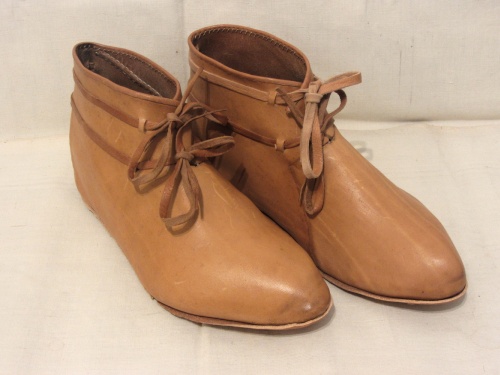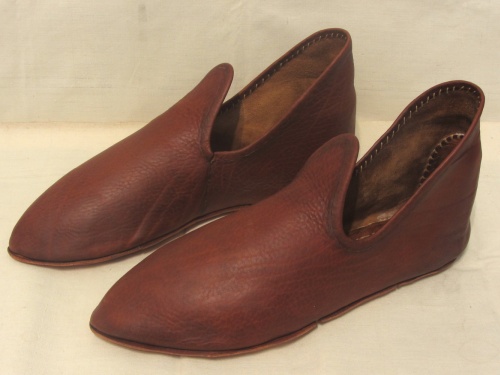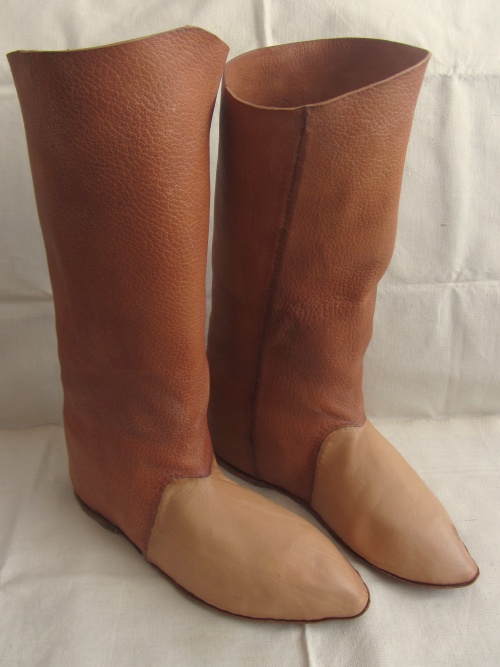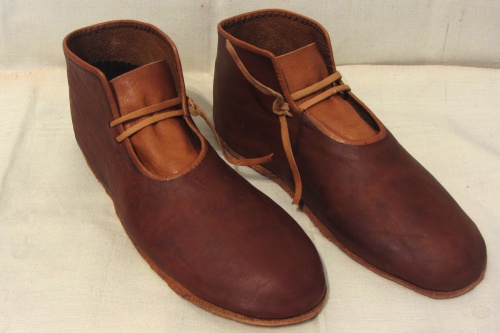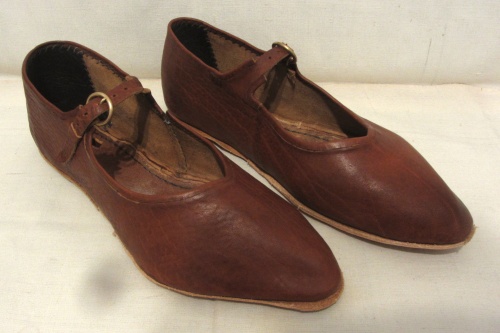It’s been a long time since I wrote anything new. But at least I was productive when it came to making shoes. Some of them have left my workshop during the last months and I would like to show them here.
Here are some ankle-high shoes with laces. One of the most frequently found types for the 13th century, worn far before and after 1. In the high versions, the upper extends approximately to the middle of the calf and is closed with a single, two or more circumferential laces. The laces are pulled through pairs of vertical slots in the upper and knotted at the side. The slits are arranged in rows on the left and right sides and occasionally at the front above the tibia. This pair is made of vegetable tanned cowhide.
Here is a pair of slip-on shoe made after a find from Konstanz 2. The shoes are completely made of vegetable tanned cowhide. The top band is made of the same leather as the upper and has been scraped down to the right thickness. This is one of the very few shoe types that does without lacing or other fastening. There are a few finds with pairwise slots for lacing, but most of the preserved fragments show no signs of fastenings. There are finds from Freiburg, Constance, Lund (SE), Maastricht (NL), Hallwyll (CH), Braunschweig, Kolberg (PL) and Chillon Castle (CH). Most of the finds are dated 1400-1450, but two copies are dated around 1300 in the literature (Lund and Maastricht).
Here a high completely closed boot as one finds it starting from the first quarter of the 13th century. These boots are worn completely without any further fasteneing and have to hold on to the foot by a good fit alone.
This recreation is based on a preserved original in terms of cut, material and workmanship. Like the original, the upper is made of vegetable tanned goat leather and the vamp of vegetable tanned cowhide. In addition, a heel reinforcement was sewn in.
The description of the find still refers to an insole. This probably meant a second insole as found on some finds, for example in Schleswig3. This was not implemented in this copy. Instead, another sole was sewn on the outside of the heel. Such patches can be found in almost all larger finds. In the finds of Altenberg4 such reinforcements can also be found on new shoes, where they probably served as additional protection for the miners.
Since these boots are intended for riding and stable work, they were greased a total of 8 times until the leather no longer absorbs anything. In its current state, it can be kept under running water without the leather absorbing water. More critical is the area of the seams. Here I hope that the special edge cutting helps to make the seams tight enough. I am looking forward to the experiences of the owner.
This pair was based on a find from the castle Werdenberg (Switzerland, Canton St. gallen). The original was found a few years ago in the castle kitchen and is dated to around 1500. The Werdenberg find corresponds to the type “Mühlberg” from 1 and can be found from ca. 1480 to ca. 1525. 3 further finds of this type can be found at the name-giving Mühlberg near Kempten5 and Constance6.
In the original the back quarter was made of a different coloured leather (same kind as the tongue). However, the decision was made for a somewhat simpler design, as with the find from Constance.
This pairis intended for honorary “sister-in-law of the Countess”. Display period is 1480.
Upper leather is reddish brown vegetable-tanned cowhide. The tongue, top band and laces are made of vegetable tanned goat leather. The tongue is attached to the inside of the upper leather by stitching. Heel reinforcement is mandatory. The toes are rounded and slightly wider.
A low shoe type Schlei with a buckle fastening made of brass. In use from the 2nd quarter of the 13th century to the 1st quarter of the 14th century, the upper leather is made of cowhide with a sheepskin top band. A find from Schleswig dated after 1280 served as a model.
In the picture you can still see the strips that I have carved from two pieces of wood scraps glued together. On the right one the wood broke out a little during the carving and the slats had to be topped up with some glued leather.
All shoes can also be found in my gallery.
-
Volken, Marquita (2014). Archaeological footwear: development of shoe patterns and styles from Prehistory till the 1600’s. Zwolle: SPA Uitgevers ↩︎
-
Schnack, Christiane (1994): Mittelalterliche Lederfunde aus Konstanz. Grabung Fischmarkt. Stuttgart: Theiss (Materialhefte zur Archäologie in Baden-Württemberg, 26). ↩︎
-
Schnack, Christiane (1992): Die Mittelalterlichen Schuhe Aus Schleswig: Ausgrabung Schild 1971-1975. Neumünster: Karl Wachholtz ↩︎
-
Dahm, Claus; Lobbedey, Uwe; Weisgerber, Gerd (1998): Der Altenberg: Bergwerk und Siedlung aus dem 13. Jahrhundert im Siegerland. 1: Die Befunde. Bonn: Habelt (Denkmalpflege und Forschung in Westfalen, 34). ↩︎
-
Atzbach, Raine (2005): Leder und Pelz am Ende des Mittelalters und zu Beginn der Neuzeit: die Funde aus den Gebäudehohlräumen des Mühlberg-Ensemble in Kempten (Allgäu). Bonn: Habelt. ↩︎
-
Volken, Marquita (2010): Sondierung diverser Konstanzer Lederfunde. Investigation. Gentle Craft Files. Lausanne: Landesdenkmalamt Baden-Württemberg. Aussenstelle Konstanz ↩︎
 Adalbert Shouster
Adalbert Shouster


